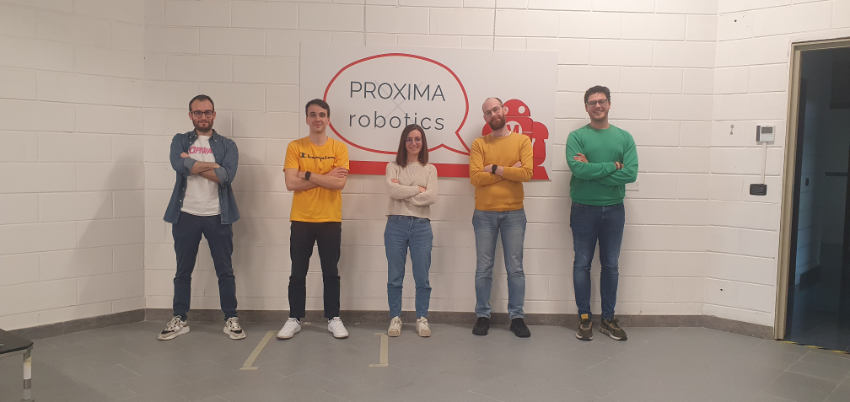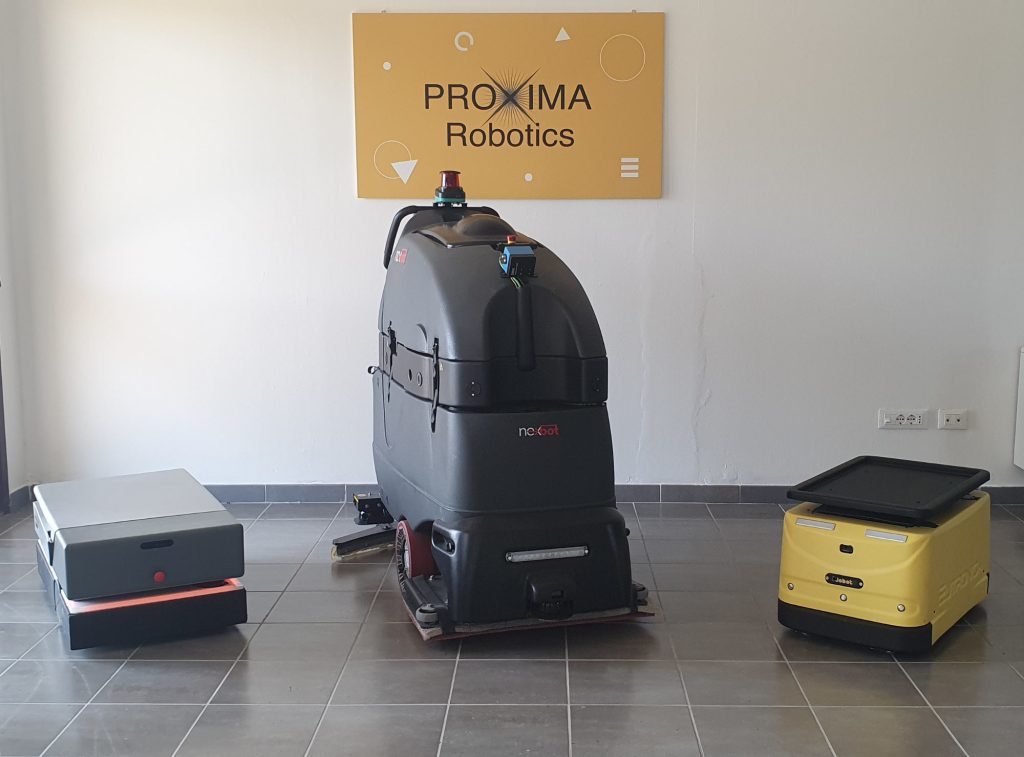Proxima Robotics is a pioneering technology company providing software products for mobile robotics. Founded in Pisa (Italy) in December 2017, with the mission to enhance people’s lives by the usage of robotics across various industries, Proxima Robotics focuses on creating intelligent, autonomous systems designed to improve efficiency, safety, and productivity.
Their product portfolio includes software for mobile robots working in logistics, warehouse automation, and manufacturing, featuring state-of-the-art and beyond navigation, sensor, and AI technologies. By integrating robotics with IoT and AI, Proxima Robotics aims to transform how businesses operate, offering scalable solutions that adapt to diverse operational needs and environments. The company is committed to driving innovation and setting new standards in the robotics industry.
Interview with Alessandro Settimi, CEO of Proxima Robotics.
What are the main areas of activity of the company?
Alessandro Settimi: Proxima Robotics provides software for mobile robots, in particular for Automated Guided Vehicle (AGV) and Autonomous Mobile Robot (AMR), the two kinds of robots used in th industrial sector to automatize material handling.
Proxima Robotics focuses on several maily these key areas of activity:
- Logistics and Warehouse Automation: where mobile robots are used for efficient material handling, inventory management, and order fulfillment.
- Manufacturing Automation: where mobile robots are used in the production line, to provide material and automatize the production process.
- Professional Cleaning Automation: where mobile robots are used to clean industrial floors.
The company is also performing preliminary tests in the Agritech sector, where robots are used to automatize agricultural tasks, such as sow, harvest, irrigate, monitor…
By addressing these diverse sectors, Proxima Robotics aims to revolutionize traditional workflows and support the digital transformation of industries. The capability to work across all these sectors is given by the unique structure of the products.
What’s the news about new products/services?
A.S: Proxima Robotics is excited to announce several new developments that showcase our commitment to pushing the boundaries of robotics and automation. Our product, Proxima Compass, is designed to revolutionize autonomous navigation for mobile robots. It includes Compass Base (our solution for autonomous navigation) and Compass Flow (our solution for brand agnostic fleet management and machinery integration).
Our products are Plug&Play softwares that can be integrated with robots just by configuring them with a no-code web-based user interface. The extreme modularity and flexible guarantee tailor solution for our customers, while keeping costs low.
Thanks to the intuitive interface, users with no expertise in robotics can configure, deploy and use the robots. Data collected by the robots are processed and used to produce advanced reports that highlight the robots’ added value.

What are the ranges of products/services?
A.S: Our products for mobile robots enable autonomous navigation and production flow management, providing robots with basic and advanced features.
Concerning autonomous navigation, our software enables sensor calibration and configuration, environment mapping, obstacle avoidance, collaboration with people and precision maneuvers.
The production flow management allows to handle robots of different brands in fleet and integrate them with production machinery, the software manages the robots and machinery status, assigning missions to the robots depending on the tasks defined by the user.
What is the state of the market where you are currently active?
A.S: The robotics and automation market is experiencing significant growth and transformation, driven by increasing demand across various industries such as manufacturing, logistics, healthcare, and retail. The need for enhanced operational efficiency, cost reduction, and improved safety has accelerated the adoption of robotics solutions worldwide.
There’s a growing need for standardization and interoperability between different robotic systems, as well as concerns about the integration of AI and machine learning into robotics in a way that ensures ethical and safe use. Additionally, while the adoption rate is increasing, there are still barriers related to the initial cost of investment and the complexity of integrating these systems into existing workflows.
Despite these challenges, the outlook is very positive. The global push towards Industry 4.0 and smart factories is opening up vast opportunities for innovation, and Proxima Robotics is well-positioned to capitalize on these trends. Our focus on developing versatile, scalable, and easy-to-integrate solutions aligns perfectly with where the market is heading.
What can you tell us about market trends?
A.S: Increased Adoption of AI and Machine Learning: AI and machine learning are becoming integral to robotics, enabling robots to perform more complex tasks with greater autonomy. This trend is evident in industries such as manufacturing, where robots are being used for predictive maintenance, quality control, and adaptive production processes.
Expansion into New Sectors: Robotics is increasingly being adopted in non-traditional sectors such as healthcare, agriculture, and retail.
Focus on Sustainability: Sustainability is becoming a significant trend, with companies looking to robotics to help reduce waste, energy consumption, and carbon footprints.
Customization and Flexibility: There’s a growing demand for robotics solutions that are highly customizable and flexible, allowing businesses to adapt to changing needs quickly.
This trend is driving innovation in modular robotics and software-driven customization, enabling companies to deploy robots that can be reconfigured for different tasks.
Human-Robot Interaction (HRI): Enhancing the interaction between humans and robots is another important trend. Advances in sensors, AI, and machine learning are improving how robots perceive and respond to human actions, making them more intuitive and easier to work with.

What are the most innovative products/services marketed?
A.S: Autonomous Mobile Robots (AMRs): These robots are designed to navigate and perform tasks independently in dynamic environments.
Collaborative Robots (Cobots): Cobots are engineered to work safely alongside human workers.
Agricultural Robots: Mobile robots in agriculture are designed for tasks like autonomous harvesting, precision planting, and weed control.
Delivery Robots: These autonomous robots are designed for last-mile delivery in urban and suburban areas.
Inspection and Surveillance Robots: These mobile robots are used for industrial inspections, particularly in hazardous or hard-to-reach environments.
Mobile Healthcare Robots: These robots assist in healthcare settings by transporting medical supplies, cleaning facilities, or even providing telepresence services for doctors and patients.
What estimations do you have for 2025?
A.S: Looking ahead to 2025, Proxima Robotics is ready for significant growth, driven by our continued focus on product innovation, strategic partnerships, and expanding our market presence.
One of our key priorities for the coming year is to deepen our collaboration with early adopters. These partnerships are invaluable in helping us refine and enhance our products based on real-world feedback. By working closely with these forward-thinking customers, we’re able to iterate quickly, ensuring that our solutions meet the evolving needs of the market and deliver tangible value. This approach not only improves our products but also strengthens our relationships with these early customers, turning them into long-term advocates for Proxima Robotics.
In addition to this, we’re actively seeking to form new strategic partnerships across different industries. These alliances are crucial for expanding our reach and integrating our technology into a broader array of applications. By partnering with key players in industries like logistics, healthcare, and manufacturing, we can accelerate the adoption of our robotics solutions, enter new markets, and create synergies that benefit all parties involved.
Overall, 2025 promises to be a pivotal year for us as we continue to innovate, grow our customer base, and establish Proxima Robotics as a key player in the global robotics industry.

